Books
Books

Spike #71 – Couples
For the latest Spike – #71: Couples—we're seeing double. This one is dedicated to partnerships in life, love, law, and labour. Whether you're a serial monogamist, married to your job, or sublimating your crushy feelings into all that you create, it's tough to deny the role that romance—or its absence—plays in shaping our subjectivities.
Might coupling be key to seeing beyond the self, opening us up to a more expansive, collaborative (co)existence? And do relationship breakdowns parallel wider social strife? Can the dusty old dyad be reconceived as radical? What happens when art-world couples blend business and pleasure?
Curl up with your soul mate—or settle into singledom—and grab a copy to read about the uses of love beyond love; the motivation posed by muses and rivals; psychoanalytic takes on partners' promises; along with artist-couples, curatorial duos, rom-com heroes, spectres, fembots, and beyond.
With Chris Kraus, Asa Seresin, Whitney Mallett, Alenka Zupančič, Johanna Hedva, Sam Kriss, Calla Henkel & Max Pitegoff, Genesis & Lady Jaye Breyer P-Orridge, Darian Leader & Jamieson Webster, Eva & Franco Mattes, Tea Hacic-Vlahovic, and many more.
Founded by the artist Rita Vitorelli in 2004, Spike (Spike Art Quarterly) is a quarterly magazine on contemporary art published in English which aims at sustaining a vigorous, independent, and meaningful art criticism. At the heart of each issue are feature essays by leading critics and curators on artists making work that plays a significant role in current debates. Situated between art theory and practice and ranging far beyond its editorial base in Vienna and Berlin, Spike is both rigorously academic and stylishly essayistic. Spike's renowned pool of contributing writers, artists, collectors and gallerists observe and reflect on contemporary art and analyse international developments in contemporary culture, offering its readers both intimacy and immediacy through an unusually open editorial approach that is not afraid of controversy and provocation.

Notes on a life not lived
This publication is based on a project by Despina Vassiliadou that ran from 2015-16. It presents a collection of photographs taken during the period, accompanied by fictional short stories.

À L’ARRACHE: Portraits & récits de la scène musicale underground de Lyon, 1980—2020
« Des nuits des fêtes et de mille concerts que reste-il ? Des souvenirs brumeux de lieux improbables, des anecdotes en pagaille, une affiche dans ton salon, un flyer sur ton frigo, des histoires vertigineuses et des émotions de toutes sortes. On pensera aussi tout de suite à des visages, des rencontres, des aamitiés aui commencent au coin du bar ou fumant une cigarette dans un hangar glacial. Et puis ça se précise: tu te souviens tel concert génial, ce groupe qui t'obsède, cette salle moquette où tu écoutais des nappes de bruit, cette villa bourgeoise squatté qui débordait de sons obscurs et violents, cette ancienne usine occupée le temps d'un week-end par des teufeurs multicolores, un dojo de métalleux ou je ne sais quel autre endroit bizarre, on en veut encore. » [note de l'editeur]
336 pages de textes et d’images
format 18 x 26 cm
Graphisme : Félicité Landrivon avec Églantine Marcel
Éditions BARBAPOP, Décembre 2021

Eecchhooeess
American poet Norman H. Pritchard's second and final book, EECCHHOOEESS was originally published in 1971 by New York University Press. Pritchard's writing is visually and typographically unconventional. His methodical arrangements of letters and words disrupt optical flows and lexical cohesion, modulating the speeds of reading and looking by splitting, spacing and splicing linguistic objects. His manipulation of text and codex resembles that of concrete poetry and conceptual writing, traditions from which literary history has mostly excluded him. Pritchard also worked with sound, and his dynamic readings—documented, among few other places, on the album New Jazz Poets (Folkways Records, 1967)—make themselves heard on the page.
EECCHHOOEESS exemplifies Pritchard's formal and conceptual sensibilities, and provides an entryway into the work of a poet whose scant writings have only recently achieved wider recognition. DABA's publication of EECCHHOOEESS is unabridged and closely reproduces the design of the original 1971 volume.
Norman H. Pritchard (1939-96) was affiliated with the Umbra group, a predecessor to the Black Arts Movement. He taught writing at the New School for Social Research and published two books: The Matrix: Poems 1960-1970 (Doubleday, 1970) and EECCHHOOEESS (New York University Press, 1971). His work was anthologized in publications including The New Black Poetry (1969), In a Time of Revolution: Poems from Our Third World (1969), Dices or Black Bones: Black Voices of the Seventies (1970), Ishmael Reed's 19 Necromancers from Now (1970), Text-Sound Texts (1980) and others.
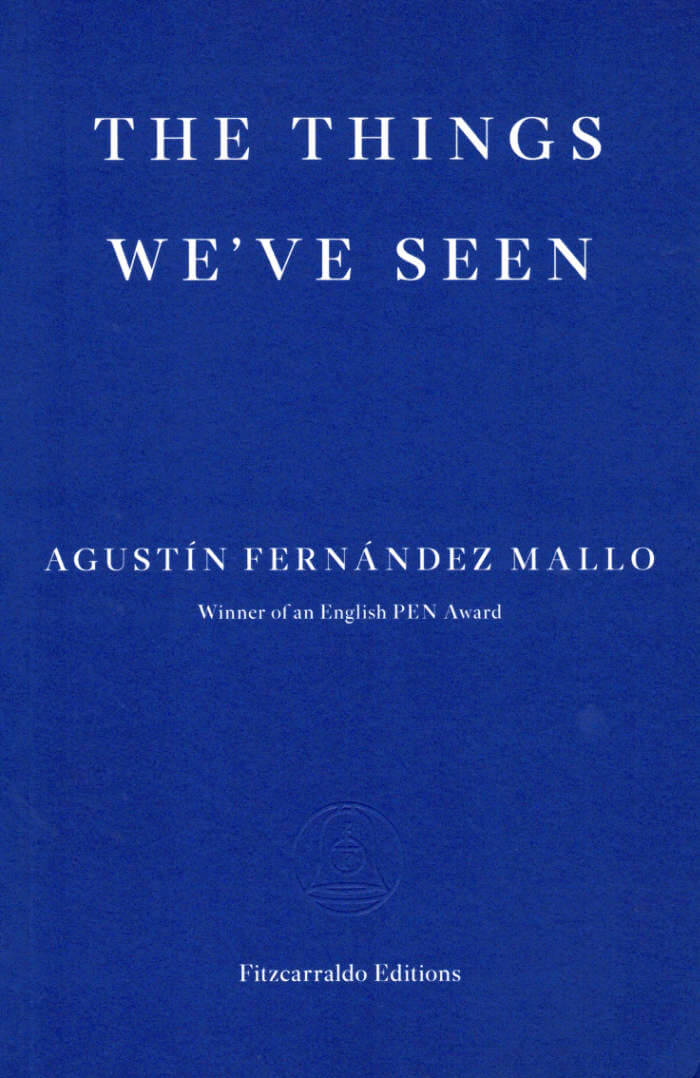
The Things We've Seen
In The Things We've Seen, his most ambitious and accomplished novel to date, Agustín Fernández Mallo captures the strangeness and interconnectedness of human existence in the twenty-first century. A writer travels to the small uninhabited island of San Simón, used as a Franquist concentration camp during the Spanish Civil War, and witnesses events which impel him on a wild goose chase across several continents. In Miami, an ageing Kurt Montana, the fourth astronaut who secretly accompanied Neil Armstrong and co. to the moon, revisits the important chapters in his life, from serving in the Vietnam War to his memory of seeing earth from space. In Normandy, a woman embarks on a walking tour of the D-Day beaches with the goal of re-enacting, step by step, another trip taken years before.
Described as the novel David Lynch and W. G. Sebald might have written had they joined forces to explore the B-side of reality, The Things We've Seen is a mind-bending novel for our disjointed times.

DWOSKINO. The Gaze of Stephen Dwoskin
Henry K Miller, Rachel Garfield
DWOSKINO. The Gaze of Stephen Dwoskin is the culmination of a three year research project, The Legacies of Stephen Dwoskin, at the University of Reading where his archive is housed. The book is a unique visual distillation of Dwoskin’s life and times, with hundreds of never-seen-before images taken from his archive, and texts by among others Laura Mulvey, Raymond Bellour, Raymond Durgnat, and Dwoskin himself.
Stephen Dwoskin (1939–2012) began his filmmaking career in the New York underground scene of the early 1960s, then moved to London in 1964, where he became a leading figure in avant-garde film, and was one of the founders of the London Filmmakers Co-operative (now LUX). His early works, such as Dyn Amo (1972), are synonymous with the male gaze. Laura Mulvey wrote that he ‘opened a completely new perspective for me on cinematic voyeurism’ and his work was a major influence on her influential work on the male gaze in cinema. From the mid-1970s, he focused his camera upon his own body, afflicted by polio during childhood, in such films as Behindert (1974) and Outside In (1981).
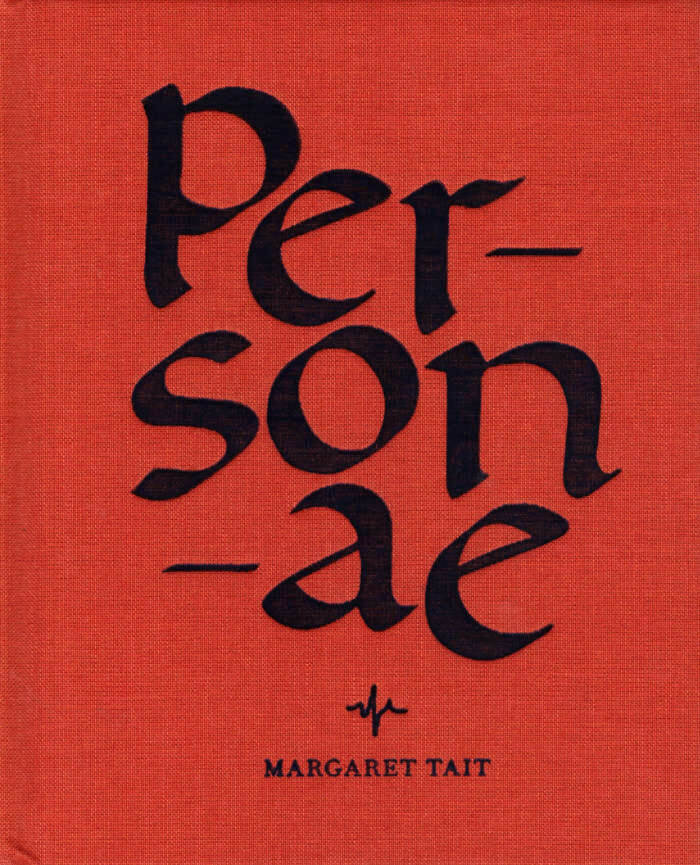
Personae
Personae is an unpublished book by Scottish filmmaker and poet Margaret Tait (1918-1999), edited by Sarah Neely with a foreword by Ali Smith
Margaret Tait (1918-1999), filmmaker and poet, is one of Scotland’s most extraordinary talents, and yet she was largely overlooked during her lifetime. Born in Orkney, she trained first as a medical doctor and served in the Royal Army Medical Corps during the Second World War, before studying film at Centro Sperimentale di Cinematographia in Rome in the early 1950s. After returning to Edinburgh, Tait established her film studio, Ancona Films, before eventually returning to Orkney in the 1960s, where she lived and continued to make films until her death in 1999.
While best known as a filmmaker, she was also a prolific writer and during her lifetime she self-published three books of poetry and two collections of short stories. Personae is her unpublished manuscript written over a number of years from 1945 onwards and painstakingly reconstructed by Sarah Neely from drafts found in the Tait archive. It is an undefinable work, part-memoir, part-experimental non-fiction; a meditation on the aftermath of war, the healing potential of the creative process, medicine, culture, relationships and an attempt to think towards a future born out of chaos. The book also offers a unique insight into the voice, mind and creative process of a singular Scottish artist whose work did not receive significant attention until after her death in 1999.

Shoot Shoot Shoot: The First Decade of the London Film-Makers' Co-operative 1966-76
The 1960s and 1970s were a defining period for artists’ film and video, and the London Film-Makers’ Co-operative (LFMC) was one of the major international centres. Shoot Shoot Shoot documents the first decade of an artist-led organisation that pioneered the moving image as an art form in the UK, tracing its development from within London’s counterculture towards establishing its own identity within premises that uniquely incorporated a distribution office, cinema space and film workshop.
Contributions from: Antony Balch, Ian Breakwell, Bob Cobbing, John Collins, David Crosswaite, David Curtis, Fred Drummond, John Du Cane, Mike Dunford, Ray Durgnat, Deke Dusinberre, Stephen Dwoskin, Gill Eatherley, Steve Farrer, Simon Field, Chris Garratt, Peter Gidal, Marilyn Halford, David Hall, Roger Hammond, Simon Hartog, Ron Haselden, Jim Haynes, Roger Hewins, Tony Hill, Jeff Keen, Ian Kerr, Jonathan Langran, David Larcher, John Latham, Malcolm Le Grice, Mike Leggett, Carla Liss, John Mathews, Harvey Matusow, Anthony McCall, Barry Miles, Jack Henry Moore, Annabel Nicolson, Jenny Okun, David Parsons, Sally Potter, Stuart Pound, William Raban, Anne Rees-Mogg, Lis Rhodes, Carolee Schneemann, Anthony Scott, Guy Sherwin, John Smith, Chris Welsby. Illustrated throughout in full colour, this book brings together a wide variety of texts, images and archival documents, and includes newly commissioned essays by Mark Webber, Kathryn Siegel and Federico Windhausen.
LUX, London / 2016
Paperback, 288 pages incl 193 full colour illustrations
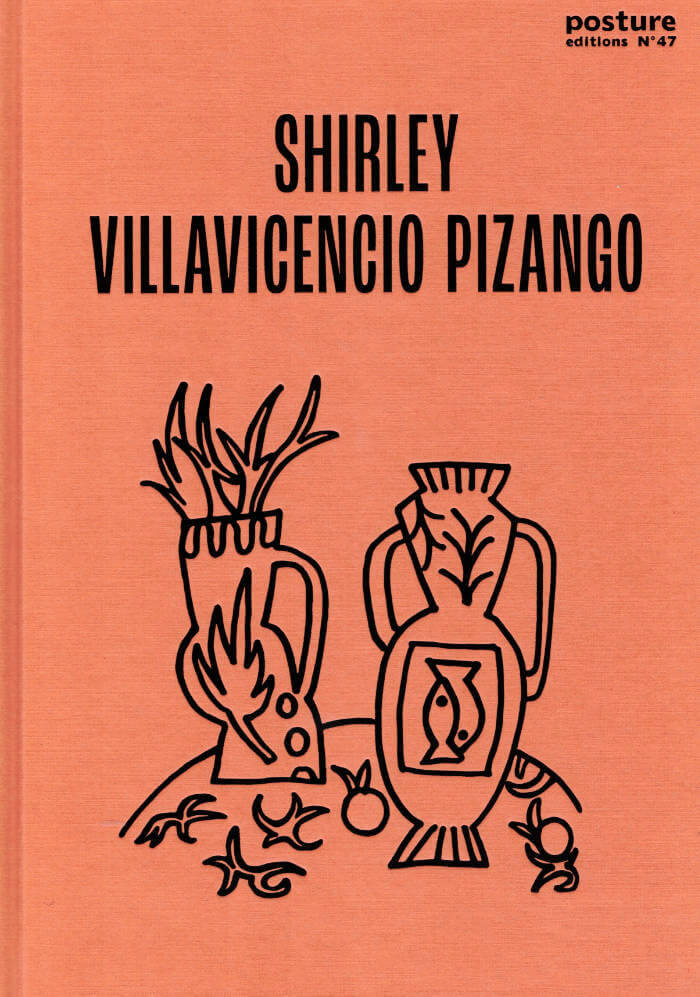
Dark Empathy
Shirley Villavicencio Pizango (b. 1988, Lima) is a Ghent-based artist with Peruvian roots. The cross-fertilization between her childhood in the Amazon jungle and Lima on the one hand, and her life in Belgium on the other, fundamentally characterizes her work.
Her young oeuvre consists of still lifes with terracotta vases, fruits or plants and decorative, colourful backgrounds. She also paints scenes for which mostly friends or family sit as models. Though it may seem that Shirley’s scenes are anchored in reality, the scenes on canvas have never taken place as a whole and her models have been transformed into characters in a constructed setting, where they are quietly allowed to be vulnerable or simply who they are.
Even the clothes and patterns are usually imaginary. Colours sometimes run; some parts appear to be left unfinished or blank.
Posture Editions N° 47, ‘Dark Empathy’, is a multi-layered hardcover presenting a selection of paintings from the last three years, interspersed with powerful drawings on paper and photographs of the artist in her studio. Bart Cassiman collected quotes to accompany the work and added some well-chosen observations by himself. The text ‘Inspired imagination’ by Benedicte Goesaert is the result of a frank conversation between the author and the expressive, generous, self-confident, but at times also melancholy artist.
"White lips refer to my memories of those moments I could not communicate with anyone because I did not yet master the Dutch language. At that time, I made drawings in which the mouth was altogether absent. Later it regained its place. The lips are often serenely pressed together because I want to immortalize the characters. For me, laughter is linked to the ephemerality of a moment. I find it fascinating to have the characters wait quietly without clear indication of what they are waiting for."
— Shirley Villavicencio Pizango in: Benedicte Goesaert, ‘Inspired Imagination’.
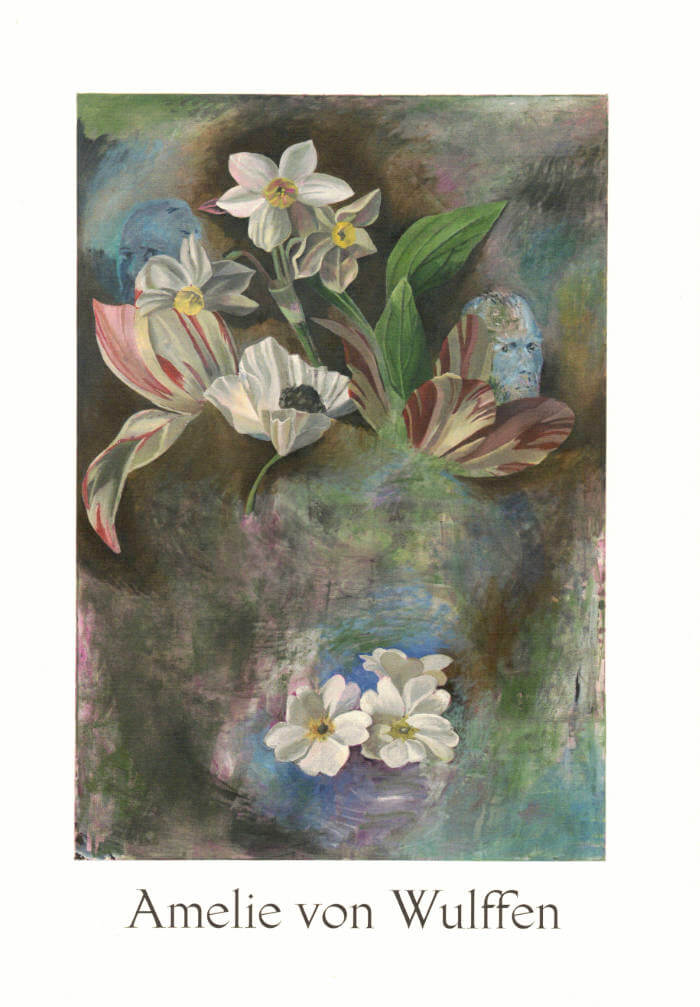
Amelie Von Wulffen
Published on the occasion of her Aspen Art Museum exhibition, the artist's first solo presentation in an American museum, this catalogue focuses on Amelie von Wulffen's recent work, including paintings created during her time as the AAM's 2012 Jane and Marc Nathanson Distinguished Artist in Residence. The artist deploys a host of painterly techniques that—while departing from the photographic collage practice for which she is best known—remain deeply referential, wryly revisiting and reprocessing tactics and tropes of modern painting from European Romanticism onward.
The lavishly illustrated publication features an essay by AAM CEO and Director, Chief Curator, Heidi Zuckerman Jacobson, as well as a foreword by Cay Sophie Rabinowitz.
Published 2013

Oslo National Academy of the Arts
Towards a Transindividual Self
A book that examines the process of performing the self, distinctive for the formation of the self in Western neoliberal societies in the 21st century. It approaches the self from a transdisciplinary angle where political and cultural anthropology, performance studies and dramaturgy intersect.
Starting from their concern with the crisis of the social, which coincides with the rise of individualism, Vujanović and Cvejić critically untangle individualist modes of performing the self, such as possessive, aesthetic, and autopoietic individualisms. However, their critique does not make for an argument for collectivism as a socially more viable alternative to individualism. Instead, it confronts them with the more fundamental problem of ontogenesis: how is that which distinguishes me as an individual formed in the first place? This question marks a turning point in the study, where it steps back into the process of individuation, prior to, and in excess of, the individual.
The process of individuation, however, encompasses biological, social, and technological conditions of becoming whose real potential is transindividual, or more specifically, social transformation. A ‘theater of individuation’ (Gilbert Simondon) captures the dramaturgical stroke by which the authors investigate social relations (like solidarity and de-alienation) in which the self actualizes its transindividual dimension. This epistemic intervention into ontogenesis allows them to expand the horizon of transindividuation in an array of tangible social, aesthetic and political acts and practices. As with every horizon, the transindividual may not be closely at hand; however, it is certainly within reach, and the book encourages the reader to approach it.
"Towards a Transindividual Self is an ambitious and capacious effort to theorize a new way to approach collectivity for political purposes through the lens of performance. Convinced that the current neoliberal conjuncture has only heightened a form of capitalist individualism that blocks notions of the social, the authors aim to show that a "transindividual formation of the self can bring about different courses of action and a more socially driven imagination." Transindividuation, they assure us, shows how "we form ourselves on the basis of interdependence, sharing, commonality, as well as indispensability of the individual as the agent of creativity/ knowledge, freedom, and change, who 'possibilizes' their own conditions of formation."
— Professor Janelle Reinelt (University of Warwick), co-editor of Critical Theory and Performance (University of Michigan, 2006)
"Perhaps the most striking thing about this book is the manner in which it is able to engage with multiple discourses from political theory to aesthetics. In this way it both follows the ambitious scope of Simondon’s work on individuation, and expands into areas that Simondon did not cover, most notably politics and cultural politics, which is the book’s central concern. Rather than ask the question is the individual imagined or real, an effect of social relations or their distortion, the focus on the transindividual makes it possible to grasp individuation as a process: “Instead of pondering how the passage from one to many occurs, individuation permits us to immediately trace a bidimensional process in which both individual persons and the collectivities they form are altered. Another meaning of the crisis of the social has brought about a perfect slogan of such a process of transindividuation: ‘No one will be left alone in the crisis.” (…) Towards a Transindividual Self does a brilliant job of not only arguing for the importance and relevance for the transindividual as a concept for politics, performance, and the politics of performance, but of demonstrating a bold standard for political and aesthetic inquiry."
— Professor Jason Read (University of Maine), author of The Politics of Transindividuality (Brill, 2015)
Co-published by Oslo National Academy of the Arts, Sarma and Multimedijalni institut.
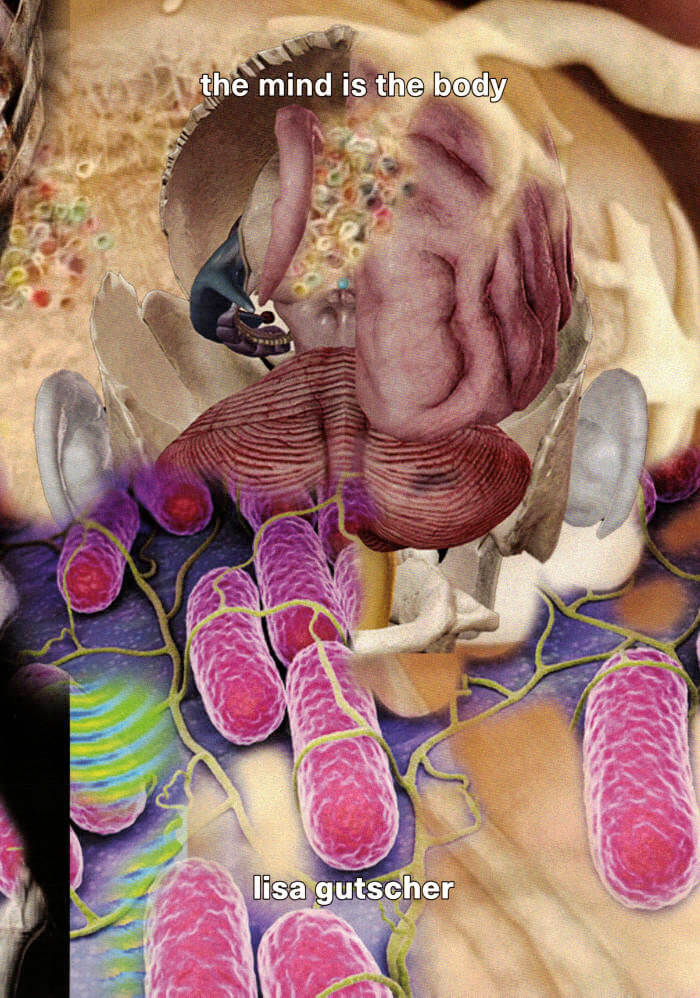
the mind is the body
Printed on thick cardboard, this book throws you right back into the child-like explorer mode we know from when we were young. It illustrates the mindful written words of Lisa Gutscher journey through the inner body based on a large archive from found images, screenshots and other image sources to unfold a whole new world in front of your eyes.

Top Stories
Top Stories was a prose periodical published from 1978 to 1991 by the artist Anne Turyn in Buffalo, New York, and New York City. Over the course of twenty-nine issues, it served as a pivotal platform for experimental fiction and art through single-artist issues and two anthologies. The entire run of Top Stories is collected and reproduced here across two volumes.
Top Stories primarily featured female artists, though in Turyn’s words a few men “crept in as collaborators.” Although primarily “a prose periodical” (as its byline often stated), the issues varied in form and aesthetics, pushing the boundaries of what prose could be and, from time to time, escaping the genre altogether. In fact, the only parameters required for participants were that the periodical’s logo and issue list be included on the front and back covers, respectively.
A great deal of the works are short stories by the likes of Pati Hill, Tama Janowitz, and Kathy Acker, whose Pushcart Prize–winning “New York City in 1979” appeared for the first time in book form as part of the series. Constance DeJong contributes “I.T.I.L.O.E.,” a widely unavailable work that features the artist’s trademark prose and is sure to please fans of her novel, Modern Love. The largest issue of the periodical is undoubtedly Cookie Mueller’s “How to Get Rid of Pimples,” which consists of a series of character studies of friends interspersed with photographs by David Armstrong, Nan Goldin, and Peter Hujar altered with freshly drawn blemishes.
Top Stories also celebrates less conventional literary forms. Issues by Lisa Bloomfield, Linda Neaman, and Anne Turyn take the form of artists’ books, juxtaposing image and text to construct tightly wound, interdependent narratives. Jenny Holzer and Peter Nadin present a collaborative work in copper ink comprised of truisms by Holzer on corporeal and emotional states and drawings by Nadin of abstract bodies. Janet Stein contributes a comic, while Ursule Molinaro provides a thorough index of daily life (and the contempt it produces) consisting of entries that were written just prior to lighting a cigarette.
Top Stories remains vitally defiant, an essential witness to what was the downtown literary and art-world underground.
Primary contributors include Kathy Acker, Laurie Anderson, Sheila Ascher, Douglas Blau, Lisa Bloomfield, Linda L. Cathcart, Cheryl Clarke, Susan Daitch, Constance DeJong, Jane Dickson, Judith Doyle, Lee Eiferman, Robert Fiengo, Joe Gibbons, Pati Hill, Jenny Holzer, Gary Indiana, Tama Janowitz, Suzanne Johnson, Caryl Jones-Sylvester, Mary Kelly, Judy Linn, Micki McGee, Ursule Molinaro, Cookie Mueller, Peter Nadin, Linda Neaman, Glenn O’Brien, Romaine Perin, Richard Prince, Lou Robinson, Janet Stein, Dennis Straus, Sekou Sundiata, Leslie Thornton, Kirsten Thorup, Lynne Tillman, Anne Turyn, Gail Vachon, Brian Wallis, Jane Warrick, and Donna Wyszomierski.
David Armstrong, Nan Goldin, JT Hryvniak, Peter Hujar, Nancy Linn, Trish McAdams, Linda Neaman, Marcia Resnick, Michael Sticht, and Aja Thorup all make appearances as well, contributing artwork for the covers or as illustrations.
Anne Turyn (b. 1954) is a photographer based in New York. Turyn’s work has been exhibited at the Museum of Modern Art, the Metropolitan Museum of Art, Kunsthalle Bern, Denver Art Museum, Walker Art Center, and Los Angeles County Museum of Art.
Published by Primary Information, 954 pgs, 21.6 × 14 cm, 2 Paperback books in Slipcase, 2022

Confidences / Majority
The uprising was staged by the minority, and a downfall is remembered by the majority.
Gilgamesh “Gil” Gupta is a theatre maker and self-defined “avant-gardist.” As a young vampire, Gil’s alienation from time, body, and identity only increases with the murder of his sire, Patrice. Seasons pass in spite of this, and Gil endeavours to circumvent inter-species edicts to foster a meaningful audience. Recognition becomes a vocation.
Confidences / Majority is a novel that presents entertainment as critical gospel. Seething a trail of cultural debris, Majority is the second instalment in Ivan Cheng’s Confidences series, which deploys a version of the vampire and performance as sites for transformation and maintenance.
Ivan Cheng (b. 1991, Sydney) produces films, objects, paintings and publications as anchors for the staging of complex and precarious spectacles. His background as a performer and musician form the basis for his using performance as a critical medium and questioning publics and accessibility. He holds an MFA in Critical Studies from Sandberg Instituut; his work has recently been presented at Voiture14 (Marseille), La Maison Pop (Montreuil), Les Urbaines (Lausanne), Volksbühne Roter Salon (Berlin), Oude Kerk (Amsterdam), Belvedere21 (Vienna), MuHKA (Antwerp), Carriageworks (Sydney), Federation Square (Melbourne). In 2017 he initiated the project space bologna.cc in Amsterdam.
Confidences / Majority is published simultaneous to Cheng’s solo presentation Milieu at Édouard Montassut, Paris.

Supplication: Selected Poems of John Wieners
Supplication: Selected Poems of John Wieners gathers work by one of the most significant poets of the Black Mountain and Beat generation. Includes poems that have previously never been published, the full text of the 1958 edition of his influential The Hotel Wentley Poems, plus poems from rare sources, facsimiles, notes, and collages by Wieners. An invaluable collection for new and old fans.
John Wieners (1934-2002) was a founding member of the New American poetry that flourished in America after the Second World War. Upon graduating from Boston College in 1954, Wieners enrolled in the final class of Black Mountain College. Following Black Mountain's closure in 1956, he founded the small magazine Measure (1957-1962) and embarked on a peripatetic life, participating in poetry communities in Boston, San Francisco, New York, and Buffalo throughout the late 1950s and 1960s, before settling at 44 Joy Street in Boston in 1972. He is the author of seven collections of poetry, three one-act plays, and numerous broadsides, pamphlets, uncollected poems, and journals. Robert Creeley described Wieners as the greatest poet of emotion of their time.

4 Basic Kinds of Lines & Colour
On occasion of the Book as System exhibition, we are thrilled to publish a facsimile reprint of Sol LeWitt’s iconic Four Basic Kinds of Lines & Colour, co-published Printed Matter, Inc. & Primary Information.
Published in 1977 by Lisson Gallery, Studio International, and Paul David Press, the 34 page staple-bound book is an early example of LeWitt’s rigorous, algorithmic process in which a set of rules is run through its permutations to generate corresponding images. First in overview and then in detail, the publication sets down all possible combinations in overlaying four basic lines (vertical, horizontal, right-facing diagonal, left-facing diagonal) followed by a distinct combinatory system of four basic colors (yellow, black, red, blue).
Each spread is composed of these two parallel systems played out one at a time, with escalating line combinations on the left hand side and corresponding color combinations on the right. LeWitt’s Four Basic Kinds of Lines & Colour (1977) followed the publication of Four Basic Kinds of Straight Lines (Studio International, 1969) and Four Basic Colours and their Combinations (Lisson Gallery, 1971), and serves as a kind of synthesis of the two systems described in those earlier volumes.
Published by Printed Matter, Primary Information, 34 pgs, 20 × 20 cm, Softcover

My Life as a Godard Movie
Captivated by the liberated glamour of Jean-Luc Godard’s young stars as a teenager, Joanna Walsh rediscovers his films as an adult and finds herself resisting the temptation to identify with or desire the women on film. Instead, echoing Jean-Luc Godard’s pronouncement that ‘cinema is truth at 24 frames per second’, Walsh’s essay turns its gaze on the dynamics of the camera itself and demands a new kind of art. This is an experimental, bold, and wide-ranging book that refuses to setltle for easy answers. An essential read for anyone interested in women on film.

Fleurs du Mal
Charles Baudelaire, Antoine D'Agata
For Charles Baudelaire, the photographic medium is not an art but a technical means of representing reality. As a counterpoint to Baudelaire, Antoine d’Agata reworks his own photographs through digital intervention to return to engraving, as if to go from the pixel to the line of the time. He pushes photography to its limits, discarding the medium to return to the raw. Baudelaire’s texts thus enter into dialogue with photographs that have become engravings through wear and tear and manipulation, where the bodies blend together to give way to the poetry of the body.
The work is based on the original uncensored edition of Baudelaire’s collection accompanied by these engraved prints by d’Agata. Present and past are superimposed. Like a game of transparency that will present the frame of an image on the cover. In this work Fleurs du Mal, Baudelaire is a stroller, a spectator of the world around him, of urban transformations, while d’Agata embodies photography, life and reappropriates the space of the city by the gesture.
Two personalities meet on the occasion of the 200 years of the birth of Charles Baudelaire. Two artists who could have meet each other, debated, confronted each other. For d’Agata, Baudelaire leaves a legacy that must be pushed to extend its own reflection.
The artist intervenes on the edge of Baudelaire’s poems with personal reflections and quotations from his favorite thinkers, descendants of Baudelaire’s thought: Walter Benjamin, Guy Debord or Georges Bataille.
Affixed vertically to the poems, these handwritten interventions assert themselves while leaving the original text its own space. A second sense of reading is thus offered to the reader between Baudelaire’s text and the interpretation given by d’Agata through the words as much as through the engravings.

Hunters Follow Harpy Shadows
Hunters Follow Harpy Shadows is an experimental work featuring a series of poetic writings that explore fantasy narratives of rewritten mythologies. Mixing re-imagined trans Korean folklore, queered Biblical storytelling and pirate lore, the publication is an amalgamation of writing delivered from the lips of the artist as a genderfluid seraphim that has left heaven to tell mortals of the other worlds.
Across twenty-five chapters, Rin Kim’s text recounts the tangled, cosmic history of shapeshifting goddexes intermixed with an otherworldly cast of demis, dryads, wraiths, satyrs, tieflings and sirens. Taking cues from the Old Testament, fantasy storytelling, and the depths of fanfiction forums online, the project alternates between narrative storytelling in the direct mode of epic religious texts and a series of Psalmic interventions spoken in the innermost voice of the gods. Like a series of connected visions, Hunters Follow Harpy Shadows hands down the origin stories of distant worlds — of clashing immortals, species dying out, and deities fading from power. It is both a fantasy saga beset by violence, warfare and blood sacrifice, and a lovers’ song of longing and transcendence.
During the origins of the earth, mortals sacrificed their children to the belly of the depths, to Yawong: god of subservience and singularity…
Central to the project are new images by Oliver Davis, shot on 35mm film, which offer views of a fragmented landscape — jewel-like glimpses of sunlit trees, river stones, and murky underbrush. The lush world seen in these photographs, a version of earth devoid of all humans and figures, provides a quiet space outside of time for staging the mythic struggles of the gods. The book’s typography suggests perhaps an ancient document or illustrated manuscript; the sharp, secret lettering carrying the magic properties of a blade used to split worlds.
Design: Rin Kim
Photography: Oliver Davis
Editing: Olivia Ross
Production: The Uses of Literacy
Cloth-bound hardcover (Feincanvas), with cover tip-in and metallic foil stamping
Rin Kim, born in 1997 in Watertown, New York; is a multi-diciplinary trans chimera, demi, hydra, mutt, graphic designer, filmmaker, alchemist, performance artist, writer, and yong working around non-binary mythologies, ritual storytelling, and fantasy. Their work is a hyperfocused movement of a particular upheaval, an ongoing irruption that re-arranges every assumption of the equivalence of subjectivity and identity.
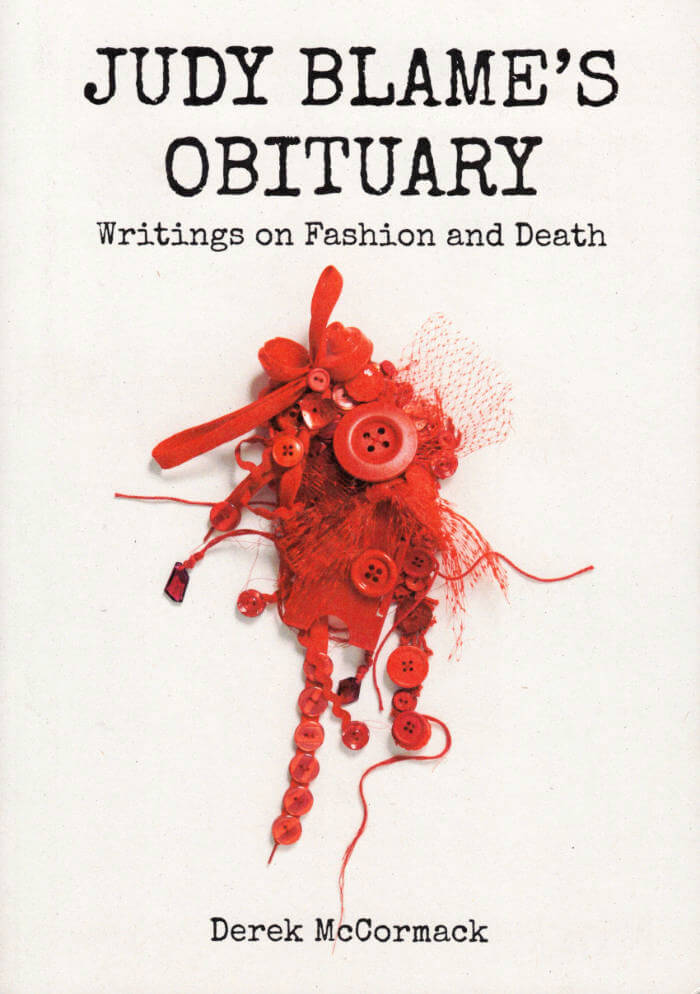
Judy Blame’s Obituary: Writings on Fashion and Death
Derek McCormack is the author of fashion-inflected novels that cast luminaries such as Elsa Schiaparelli and Balenciaga as characters. This collection brings together for the first time McCormack's fashion journalism. He writes about and interviews fashion figures that fascinate him, tracing the ways they inspire and inhabit his novels. The result is a sort of memoir in essays: as he writes, "My tribute to [Judy] Blame is about him and about me—there are lots of my own tales woven in with the topics I touch on. The writing here is a sort of autobiography, a life seen through a scrim, or a life as a scrim—my moire mémoire."
Judy Blame's Obituary contains twenty years' worth of reminiscences, reviews of fashion shows and books, interviews with writers about fashion, and interviews with fashion designers about writing. He talks to Nicolas Ghesquière about perfume, and to Edmund White about which perfume he wore as a young fag in New York City. He inspects the clothes that Kathy Acker left behind when she died, and he summons the spirit of Margiela in a literary seance. He traces the history of sequins, then recounts the cursed story of Vera West, the costume designer who dressed the Bride of Frankenstein. These pieces were all previously published, some in Artforum, some in The Believer, and some in underground publications like Werewolf Express—what binds them together is a sense that though fashion victimizes us, this victimization is sometimes a sort of salvation.
Derek McCormack is a Canadian writer. His most recent novels are The Well-Dressed Wound and Castle Faggot, both published by Semiotext(e). Of Castle Faggot, Dennis Cooper said: "It is really just one of the best books ever, and maybe the greatest novel ever written.
Praise for Judy Blame's Obituary:
'Derek McCormack, Canada's most famous author as yet unsullied by Nobel Prize or television adaptation, hides in plain sight as a fashion journalist. Parallel to his writing incantatory, scatalogical fiction, he has reviewed collections and interviewed the great and good of la mode. His divagations are often darkly hilarious and always exquisitely tailored. The sublime and the ridiculous coexist in his prose, as they do in life. Fashion victims, ignore his insights at your peril.' — William E. Jones
Published by Pilot Press, 20 × 15 cm, Softcover, 2021

Responses to Derek Jarman’s Blue
Responses to Derek Jarman's Blue is the third publication in a series of anthologies from Pilot Press seeking contemporary responses to works of art made during the AIDS crisis.
In this third iteration, responses were sought to the 1993 film Blue by the multidisciplinary artist Derek Jarman.
Contributors
In order of appearance
Roelof Bakker
Jared Davis
Becca Albee
Linda Kemp
Ashleigh A. Allen
David Nash
Sam Moore
Anton Stuebner
Gonçalo Lamas
Olivia Laing
Nate Lippens
Jason Lipeles
JP Seabright
Andrew Cummings
Sig Olson
Maria Sledmere
Cleo Henry
Jessie McClaughlin
Lars Meijer
Scott Treleaven
Declan Wiffen
Caitlin Merrett King
Harry Agius
António Manso Preto
Adriana Lazarova
Brooke Palmieri
D Mortimer
Mary Manning
Aaron James Murphy
Printed on 100% recycled paper
Published by Pilot Press, 20 × 15 cm, Softcover, 2022
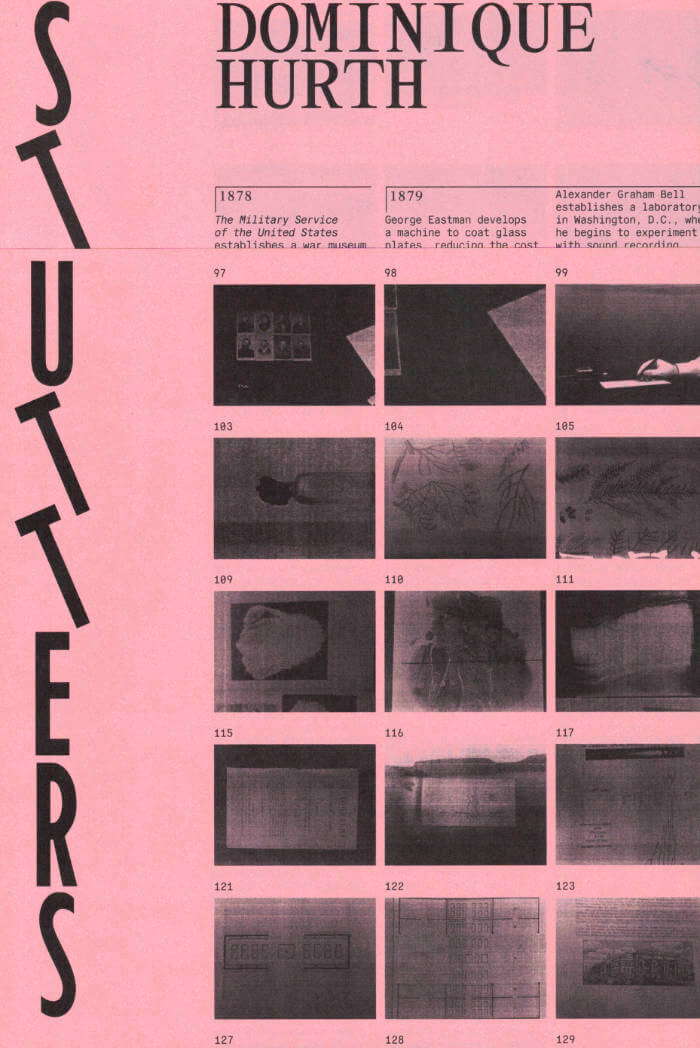
Stutters
In 2014, Hurth encountered four boxes of cyanotype prints by Thomas W. Smillie, the first custodian and curator of the Smithsonian Institution’s collection of photography (active 1868 to 1917). In her new work Stutters, Hurth builds on several years’ research to rework the original cyanotypes into visual montage, sequencing images that provide a record of Museum life as it documents a ‘national’ collection in the making. The work presents photographs of empty display cabinets and staged objects within the Smithsonian’s holdings, following divergent threads of photographic history, exhibitionship and collection-making, as well as developments in various technological apparatuses across the late 19th and early 20th century.
Through a meticulous process of xerox and printing reproduction, Hurth enlarges the world of each image and traces a photographic lineage, a process itself indebted to the cyanotype. Two overlapping sets of captions from the artist offer a subjective and scientific view of the photographs, inviting a cross-referencing of the “official”, if incomplete, bibliographic record with one that moves more freely across a historical timeline as a way to reflect on gaps in the archive.
Stutters includes three new texts, with Hurth considering the book’s entwined interests, as well as her own personal history with the Smithsonian and the work of Smillie. Additional contributions by authors and curators Ruth Noack and Kari Conte consider the ways in which artists’ projects like Stutters can quietly break apart the violent taxonomy of an archive, and instead use this shifting fragmentation to envision new meaning and bring into focus voices that have been excluded from history.
Dominique Hurth Born in France (1985), Dominique Hurth is a visual artist working with sculpture and installation, and within the relationship between sculptural matter and printed matter. Even though her installations are often concentrated on the form, a long and detailed research is strongly embedded in the development of this same form. It is by ways of archival research, journalistic investigation, writing and material experiments that the works develop, and it is by way of editing that the installation operates in the exhibition space. Her work was exhibited in several museums, galleries and institutions internationally (a.o. Palais de Tokyo, Paris; Hamburger Bahnhof, Berlin; Fundacio Tapies, Barcelona; Memorial of Ravensbrück, Fürstenberg/Havel; Württembergischer Kunstverein, Stuttgart) and is part of several collections. She is the recipient of several awards and residencies such as the Pollock-Krasner Foundation Grant (2016-17) and Prize of the Berliner Senate / Governing Mayor of Berlin at ISCP, New York (2014).

Bricks from the Kiln — Issue 4: On Translation, Transmission & Transposition
Andrew Walsh‐Lister, Matthew Stuart and 2 more
Bricks from the Kiln is an irregular journal edited by Andrew Lister and Matthew Stuart, sometimes with guest editors, that presents graphic design and typography as disciplines activated by and through other disciplines and lenses such as language, archives, collage, and more. It borrows its title from the glossary notes of Ret Marut’s "Der Ziegelbrenner," which was the ‘size, shape and colour of a brick’, and ran for 13 issues between 1917 and 1921.
The latest installment, "#4: On Translation, Transmission & Transposition," was published as an event (and now) a publication, with events at London College of Communication, Burley Fisher Books & Pig Rock bothy, Socttish National Gallery of Modern Art, and Inga (in November, 2019).
GREENING
Helen Marten
(front / back flaps)
JOY & HAPPINESS, FIDELITY
& INTIMACY IN TRANSLATION
Sophie Collins
(pp.4–13)
PLANETARY TRANSLATION
Don Mee Choi
(pp.15–19)
TRANSLATION AND A LIPOGRAM:
OR, ON FORMS OF AGAIN-WRITING
AND NO- (OR NOT THAT-) WRITING
Kate Briggs
(pp.23–33)
UNHOMING (1 of 4):
FOLLOWING HÖLDERLIN’S ‘HEIMAT’
Phil Baber
(pp.35–47)
SNOW WHITE AND THE WHITE
OF THE HUMAN EYEBALLS
Joyce Dixon
(pp.51–62)
ALTAMIRALTAMIRALTAMIRA
Florian Roithmayr
(pp.65–116)
LEVEL UP, LEVEL DOWN
Jen Calleja
(pp.119–124)
TRANS.MISSION [A.DIALOGUE]:
A JAVASCRIPT FOR THREE VOICES
J.R. Carpenter
(pp.127–134)
THE MECHANISATION OF ART
Edgar Wind
(glosses / annotations / insertions by
Natalie Ferris & Bryony Quinn)
(pp.137–144)
UNHOMING (2 of 4)
Phil Baber
(p.147)
COMMISSION FOR A NOIR MOVIE
B IN THE BAY OF BISCAY
Rebecca Collins
(pp.151–157)
UNHOMING (3 of 4)
Phil Baber
(pp.150–162)
EVERY CONTACT LEAVES A TRACE;
TRANSCRIBING OSTEON
Naomi Pearce
(pp.165–170)
HOW DOES A WORK END?
Karen Di Franco
(pp.173–193)
METONYMY Op.1 & Op.2
James Bulley
(pp.197–201)
AFRIKAN ALPHABETS EXTENDED
Saki Mafundikwa
(pp.204–207)
SUSAN HILLER: 1983
Natalie Ferris
(pp.209–217)
EVERY TELLING HAS A TALING /
EVERY STORY HAS AN ENDING
Matthew Stuart
(pp.220–233)
GRAPHIC PROPRIOCEPTION
James Langdon
(pp.235–254)
UNHOMING (4 of 4)
Phil Baber
(pp.257–263)
TUNNELLING AND AGGREGATING
FOR DESIGN RESEARCH
Bryony Quinn (text) &
Peter Nencini (images)
(pp.265–272)
LET IT PERCOLATE:
A MANIFESTO FOR READING
Sophie Seita
(pp.275–280)
288 pgs, 22.4 × 17 cm, Softcover, 2020

As Celebration, As Critique, As Play: Ron Hunt, Selected Writings (1957-2020)
The first standalone title on the BFTK imprint, ‘As Celebration, As Critique, As Play’ pulls together selected writings by Ron Hunt across his varied career as a writer, librarian, curator, critic and self described ‘lapsed anarchist’. Structured as a ‘biographic bibliography’ supplemented with annotations and contextual notes, ‘As Celebration, As Critique, As Play’ combines commissioned writing and previously unpublished texts that range from exhibition catalogue essays and détourned Q&As, to A–Z indexes and cherry-picked readers. Writings reproduced in full include:
Francis Picabia: Introduction (1964)
Yves Klein: A Mythopoeic of the Plurisignative (1967)
The Arts in Our Time (1968)
We Are Revealing New Pages of Art in Anarchy’s New Dawns (1968)
Interview with Brigitte Bardot (1969) (preview)
Poetry must be made by all! / Transform the world! (1969)
An Interview with Pontus Hultén, Stockholm 1981 (1971)
For Factography! (1976)
Andreas Gursky (1999)
Kalf: A Late Perspective (2000)
Dreams of / Fears of …… Flying (2009)
Fourier / Breton / Cherries (2017)
Hélène Cixous or Waiting for Tears (2018)
Some Books of Barbara Bloom (2019)
A Very Brief Dictionary in the Vicinity of Situationism (2019)
‘Recovery’ / Is Recovery Possible (2020)
with photographs by Tom McCaughan
typeset in Janson Max Neue by Dinamo & Sam de Groot
224 pgs, 21 × 15 cm, Softcover